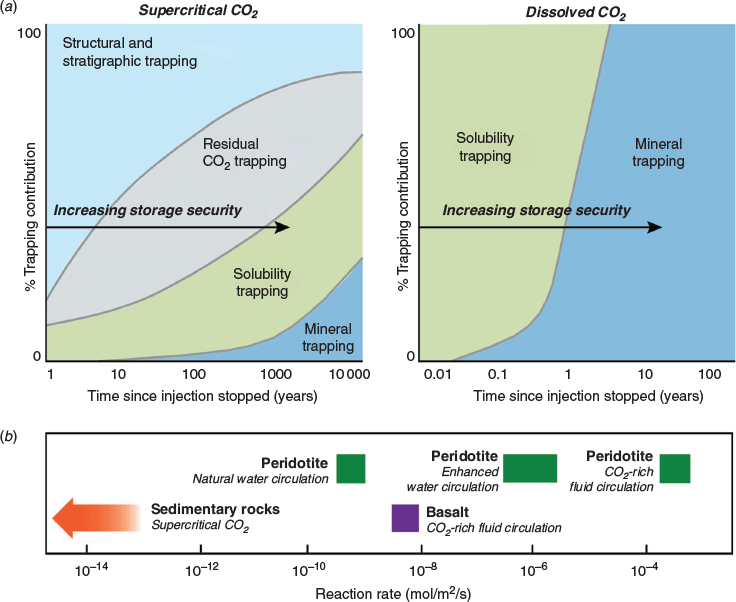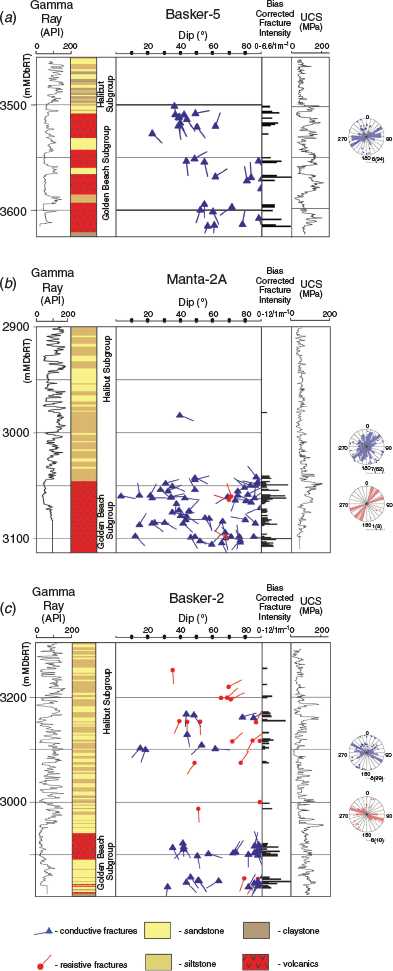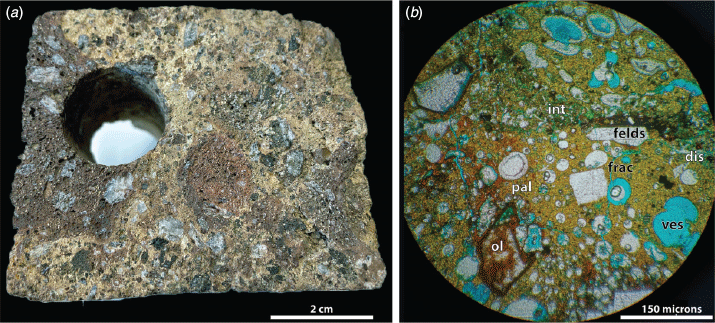Storing CO2 in buried volcanoes
Simon Holford A D , Nick Schofield B , Mark Bunch A , Alan Bischoff C and Ernest Swierczek AA Australian School of Petroleum and Energy Resources, University of Adelaide, Adelaide, SA 5005, Australia.
B Department of Geology and Geophysics, University of Aberdeen, Aberdeen AB24 3UE, Scotland.
C School of Earth and Environment, University of Canterbury, Christchurch 8140, New Zealand.
D Corresponding author. Email: simon.holford@adelaide.edu.au
The APPEA Journal 61(2) 626-631 https://doi.org/10.1071/AJ20056
Accepted: 4 March 2021 Published: 2 July 2021
Abstract
Australia contains rich natural gas resources, but many of Australia’s currently producing and undeveloped gas fields contain relatively high CO2 contents; if not captured and stored, the venting of co-produced CO2 could hinder efforts to meet Australia’s emission reduction targets. The most mature technology for isolating produced CO2 from the atmosphere is by containing it in deep sedimentary formations (e.g. saline aquifers or depleted oil and gas reservoirs). The effectiveness of this approach is dependent on factors such as reservoir capacity, the presence of low-permeability seals that physically impede vertical migration of injected CO2, the chemical reactivity of both reservoir and seal minerals, the risk for leakage, and a gas-entrapping structure. An alternative and attractive mechanism for permanent storage of CO2 is geochemical or mineral trapping, which involves long-term reactions of CO2 with host rocks and the formation of stable carbonate minerals that fill the porosity of the host rock reservoir. Natural mineral carbonation is most efficient in mafic and ultramafic igneous rocks, due to their high reactivity with CO2. Here we review the outcomes from a series of recent pilot projects in Iceland and the United States that have demonstrated high potential for rapid, permanent storage of CO2 in basalt reservoirs, and explore the practicalities of geochemical trapping of CO2 in deeply buried basaltic volcanoes and lava fields, which are found in many basins along the southern (e.g. Gippsland Basin) and northwestern (e.g. Browse Basin) Australian margins, often in close proximity to natural gas fields with high CO2 content.
Keywords: CCS, CO2, reservoirs, basalts, buried volcanoes.
Introduction
Australia contains abundant natural gas resources and is a leading global exporter of liquified natural gas (LNG) (Geoscience Australia 2019). Many of Australia’s producing and undeveloped natural gas fields contain relatively high CO2 contents, with particularly high values (>20%) reported from wells and fields in the Otway, Cooper-Eromanga, Gippsland, Bonaparte, and Carnarvon basins (Boreham et al. 2001). For some producing fields, most notably Gorgon (~7–27% CO2: Maftei et al. 2013), CO2 is separated and injected into deep saline aquifers (Michael et al. 2010). In many fields, however, reservoir CO2 is not captured but directly released to the atmosphere, contributing significantly to national greenhouse gas emissions. The Ichthys Field in the Browse Basin contains high CO2 contents in the Brewster (8%) and Plover (17%) reservoirs, and it is anticipated that ~96 Mt of reservoir CO2 will be emitted over the 40-year lifetime of the Ichthys LNG project (INPEX 2010).
The most mature technology for the long-term carbon capture and storage (CCS) is underground sequestration of supercritical CO2 in sedimentary rock formations such as deep saline aquifers or depleted hydrocarbon reservoirs deep enough (typically 1 km or deeper) for the CO2 to remain in a supercritical state (Bunch et al. 2014; National Academies of Sciences Engineering and Medicine 2019). The critical requirements for CCS in sedimentary formations are (i) a thick reservoir (usually sandstone or carbonate) with sufficient porosity and permeability to contain large volumes of CO2 at commercially meaningful injection rates, (ii) an overlying thick seal (usually shale) with sufficiently high capillary entry pressure and low permeability to retain the injected CO2 over geological timescales, and (iii) a gas-trapping structure that, due to gas buoyancy, concentrates large volumes of CO2 and prevent its migration and leakage (Dempsey et al. 2015; National Academies of Sciences Engineering and Medicine 2019). Additional important geological considerations include the absence of permeable faults and fractures through the seal and favourable stresses and pore pressures to avoid reservoir or seal fracturing during injection (Nicol et al. 2017; National Academies of Sciences Engineering and Medicine 2019). The combined underground storage capacity in saline aquifers and depleted hydrocarbon reservoirs is estimated between 5000 and 25 000 Gt CO2 (Kelemen et al. 2019).
Carbon mineralisation in igneous rocks
An alternative option for the secure, long-term underground storage of CO2 is carbon mineralisation in mafic and ultramafic igneous rocks, which could potentially host up to 60 000 000 Gt CO2 (Kelemen et al. 2019). Carbon mineralisation involves the formation of stable carbonate minerals (e.g. calcite, magnesite, dolomite) through the reaction of CO2 (gas, liquid, dissolved in water or supercritical) with rocks that are rich in calcium or magnesium (Wolff-Boenisch and Galeczka 2018). Mg-rich, Ca-bearing rocks include ultramafic peridotites and mafic basalts, which contain highly reactive minerals including olivine and pyroxene (National Academies of Sciences Engineering and Medicine 2019). Whilst in situ carbon mineralisation in sandstone reservoirs can occur over timescales of thousands of years, peridotites and basalts may mineralise and sequester 90% of the injected CO2 in a few months to decades (Fig. 1a; National Academies of Sciences Engineering and Medicine 2019).

|
The rate of carbon mineralisation is influenced by factors including the available CO2 dissolved in solution, temperature and variations in pH, with low pH promoting mineral dissolution and high pH accelerating carbonate precipitation (Kelemen et al. 2019). Olivine (Mg2SiO4), which is the major mineral in peridotite, has amongst the highest reaction rates with CO2-bearing aqueous fluids, whilst plagioclase feldspar (the major constituent of basalts) has somewhat lower reaction rates, meaning that CO2 mineralisation may be expected to occur more rapidly in peridotites than basalts (Fig. 1b; Kelemen et al. 2019; Seyyedi et al. 2020). However, an exception may occur where basalts contain amorphous glass horizons, which are thought to provide exceptionally good reactants for carbon mineralisation (National Academies of Sciences Engineering and Medicine 2019). Glass forms when basalt cools very quickly and is often abundant in submarine lavas and hyaloclastite breccias (National Academies of Sciences Engineering and Medicine 2019).
Basaltic rocks are extremely abundant; most of the ocean floor (comprising ~70% of Earth’s surface) and >5% of the continents is basaltic, with extensive flood basalt fields present in central India, Siberia, the United States, and Canada (Snæbjörnsdóttir et al. 2020). Counter to many petroleum geologists and engineers’ assumptions, volcanic rocks often have high porosity and permeability (Fig. 2), particularly when fractured (Massiot et al. 2017; Kelemen et al. 2019; Bischoff et al. 2020; Millett et al. 2020). Two recent pilot projects have demonstrated the potential for CO2 storage through carbonate mineralisation in basalt reservoirs. In the Wallula project in Washington State, 977 tons of pure CO2 was injected into high-permeability basalt flow tops at depths between 882 and 887 m over 3 weeks in August 2013 (McGrail et al. 2017). Whilst it is not yet known what proportion of injected CO2 has formed carbonate minerals and how much remains within pore fluids, drill core from the injection zone indicates high rates of basalt dissolution and CO2 mineralisation, consistent with laboratory experiments (National Academies of Sciences Engineering and Medicine 2019).
In addition, during phase I of the CarbFix project in Iceland, ~200 tCO2 (co-produced with SO2 in geothermal fluids) was injected into highly permeable, fractured basalts with ~10% porosity at a depth of 500 m (ambient temperature ~20–50°C). Because CO2 is not supercritical at this depth, CO2 and H2O were separately injected with proportions adjusted to ensure complete solubility of CO2 into aqueous fluid at the target depth (National Academies of Sciences Engineering and Medicine 2019). Quantification of mineral carbonisation using reactive and non-reactive tracers and isotopes has demonstrated rapid mineralisation of the injected CO2, with >95% of the injected gas mineralised within 2 years (Snæbjörnsdóttir et al. 2020). Following the success of CarbFix phase I, the project has considerably upscaled, injecting 10–20 ktCO2/year into basaltic reservoirs at a depth of ~1500 m (ambient temperature ~250°C), with tracer results continuing to indicate nearly complete loss of carbon along a ~2000 m flow path (National Academies of Sciences Engineering and Medicine 2019).
Despite the success of these projects, a number of uncertainties remain, including determining the precise mineral assemblage (including alteration phases) that are reacting in the reservoirs, the passivation of reactive mineral surfaces over time, the potential clogging of pore space, and the spatial distribution of carbonate mineral precipitation versus dissolution (National Academies of Sciences Engineering and Medicine 2019). Today, the cost of storing CO2 in basalts is estimated to be US$20–30/tCO2 as compared to <US$20 for storage in sedimentary reservoirs (Kelemen et al. 2019). However, if the technology can be further proven, storage in basaltic reservoirs may become a preferred choice in volcanic provinces (Kelemen et al. 2019).
Buried basaltic sequences in Australian basins
Buried basalt lava flows and volcanoes are commonly found at depths amenable to dissolved and/or supercritical CO2 injection (i.e. >1 km) in many Australian sedimentary basins. These include the Browse and Carnarvon basins along the North West Shelf (Holford et al. 2013), and the Bight, Otway, Bass, and Gippsland basins along the southern Australian margin (Holford et al. 2012; Meeuws et al. 2016; Reynolds et al. 2017, 2018; Watson et al. 2019) and in the Eromanga Basin in central Australia (Hardman et al. 2019). In some of these basins, buried basaltic sequences are located in close proximity to gas-bearing reservoirs with high CO2 content (Holford et al. 2012).
Well-preserved basaltic submarine volcanoes are common within the Miocene Torquay Group of the Bass Basin (Holford et al. 2017; Reynolds et al. 2018), with a large (~5 km diameter) volcano overlying the Yolla Gas Field, where reservoir fluids contain ~17–20% CO2 (Holford et al. 2012; Watson et al. 2019). Core from the volcanic section penetrated by the nearby Bass-1 well, which penetrated the flank of a Miocene volcano, contains clast-supported conglomerate of dark grey microvesicular basalt interpreted to represent reworked hyaloclastite and volcaniclastic material, whilst log data and thin sections from the Tasmania Devil-1 well, which penetrated the crest of a volcano, indicate the presence of fine grained crystalline basaltic material interpreted as pillow lavas (Watson et al. 2019).
Volcanic rocks have been intersected by many wells in the hangingwall of the basin-bounding Rosedale Fault System in the northern Gippsland Basin, where numerous gas accumulations with high-CO2 content (some exceeding 30%) occur (O’Brien et al. 2008; Holford et al. 2012). The majority of these volcanic rocks are Campanian-age basalts that have been subject to various degrees of alteration (Holford et al. 2012). In some cases (and in spite of the alteration), these basalts provide the top seals to underlying gas accumulations, most notably at the Kipper field where a 328 m gross gas column (~10% CO2) within Golden Beach Group sandstones is sealed by ~98 m of volcanic rocks, interpreted to be basaltic lava flows (Sloan et al. 1992; O’Halloran and Johnstone 2001). Volcanic rocks also act as seals at Remora-1 (oil) and Tuna-4 (oil and gas) (Holford et al. 2012). Petrological and petrophysical studies of these rocks have been limited, though cuttings and sample descriptions indicate that they comprise fine-grained basaltic lavas and tuffs (McPhail 2000). However, our analysis of borehole image logs acquired through volcanic sequences in the Manta-2A, Basker-2, and Basker-5 wells demonstrates an abundance of conductive fractures (Fig. 3), raising the possibility of significant fracture-related permeability.

|
Hardman et al. (2019) have recently described a province of Jurassic extrusive and intrusive rocks within the Eromanga Basin, overlying the Nappamerri Trough of the Cooper Basin, where the highest CO2 contents (up to 40%) in gas samples are found (Boreham et al. 2001). 3D seismic interpretation coupled with log analyses indicates the presence of multiple mafic monogenetic volcanoes that extend into tabular basalt lava flows (Hardman et al. 2019). The Lambda-1 well intersected 283 m of basalt directly underlying the Lower Jurassic Birkhead Formation, with the upper 33 m comprising heavily weathered, fractured, and vesicular facies, and the remaining 250 m comprising fresh and crystalline rock (Hardman et al. 2019). In other parts of the province, basalts have been extensively altered; Kappa-1 intersected a 120 m succession of mostly fine-grained basalt with evidence for extensive chlorite replacement of ferromagnesian minerals (Hardman et al. 2019).
Conclusions
Given the promising results from both experimental studies and pilot projects, and the close proximity of basaltic sequences to many high-CO2 content gas fields in onshore and offshore Australia, we propose that the possibility of storing CO2 through in situ carbon mineralisation in buried volcanic rocks in sedimentary basins merits further consideration. In addition to the aforementioned uncertainties related to CO2–rock–fluid interactions, further challenges specific to sedimentary basins include defining the first-order stratigraphic and permeability architecture of buried volcanic sequences in order to identify potential reservoir facies (e.g. Bischoff et al. 2021), quantifying the hydraulic and petrophysical properties of buried basaltic volcanoes and lava flows, and defining their petrological characteristics and diagenetic histories.
Conflicts of interest
There are no conflicts of interest associated with this research.
Declaration of funding
AB thanks funding from the MBIE research grant UOCX1707.
References
Bischoff, A. P., Nicol, A., Barrier, A., Beggs, M., Rossetti, M. M., Wang, H., Fensom, J., Gravley, D., Kennedy, B., and Tang, H. (2020). From seismic to pore – a five-year study of volcanic reservoirs in New Zealand. In ‘Ciclo de Charlas. Magmatismo y Systemas Petroleros’. (IAPG: Argentina.)Bischoff, A., Planke, S., Holford, S., and Nicol, A. (2021). Seismic geomorphology, architecture and stratigraphy of volcanoes buried in sedimentary basins. In ‘Volcanoes-Updates in Volcanology’. (IntechOpen.)
Boreham, C. J., Hope, J. M., and Hartung-Kagi, B. (2001). Understanding source, distribution and preservation of Australian natural gas: a geochemical perspective. The APPEA Journal 41, 523–547.
| Understanding source, distribution and preservation of Australian natural gas: a geochemical perspective.Crossref | GoogleScholarGoogle Scholar |
Bunch, M., Dance, T., Daniel, R., Lawrence, M., Browne, G., Arnot, M., and Menacherry, S. (2014). ‘Geological characterisation for Stage 2 of the CO2CRC Otway Project. Cooperative Research Centre for Greenhouse Gas Technologies’. CO2CRC Publication Number RPT12–3543. (Canberra: Australia).
Dempsey, D., O’Malley, D., and Pawar, R. (2015). Reducing uncertainty associated with CO2 injection and brine production in heterogeneous formations. International Journal of Greenhouse Gas Control 37, 24–37.
| Reducing uncertainty associated with CO2 injection and brine production in heterogeneous formations.Crossref | GoogleScholarGoogle Scholar |
Geoscience Australia. (2019). Australian Energy Resources Assessment (AERA). Available at https://aera.ga.gov.au
Hardman, J. P., Holford, S. P., Schofield, N., Bunch, M., and Gibbins, D. (2019). The Warnie volcanic province: Jurassic intraplate volcanism in Central Australia. Gondwana Research 76, 322–347.
| The Warnie volcanic province: Jurassic intraplate volcanism in Central Australia.Crossref | GoogleScholarGoogle Scholar |
Holford, S., Schofield, N., MacDonald, J., Duddy, I., and Green, P. (2012). Seismic analysis of igneous systems in sedimentary basins and their impacts on hydrocarbon prospectivity: examples from the southern Australian margin. The APPEA Journal 52, 229–252.
| Seismic analysis of igneous systems in sedimentary basins and their impacts on hydrocarbon prospectivity: examples from the southern Australian margin.Crossref | GoogleScholarGoogle Scholar |
Holford, S. P., Schofield, N., Jackson, C. A.-L., Magee, C., Green, P. F., and Duddy, I. R. (2013). Impacts of igneous intrusions on source reservoir potential in prospective sedimentary basins along the western Australian continental margin. In ‘The Sedimentary Basins of Western Australia IV, Proceedings of the Petroleum Exploration Society of Australia Symposium’. (Eds. M. Keep and S. J. Moss) (Perth, WA.)
Holford, S. P., Schofield, N., and Reynolds, P. (2017). Subsurface fluid flow focused by buried volcanoes in sedimentary basins: evidence from 3D seismic data, Bass Basin, offshore southeastern Australia. Interpretation 5, SK39–SK50.
| Subsurface fluid flow focused by buried volcanoes in sedimentary basins: evidence from 3D seismic data, Bass Basin, offshore southeastern Australia.Crossref | GoogleScholarGoogle Scholar |
INPEX. (2010). Draft Environmental Impact Assessment (EIA). Ichthys Gas Development Project. Prepared by INPEX Browse, Ltd on behalf of the Ichthys Joint Venturers (INPEX and Total E&P: Australia.)
Kelemen, P., Benson, S. M., Pilorgé, H., Psarras, P., and Wilcox, J. (2019). An overview of the status and challenges of CO2 storage in minerals and geological formations. Frontiers in Climate 1, 1–9.
| An overview of the status and challenges of CO2 storage in minerals and geological formations.Crossref | GoogleScholarGoogle Scholar |
Maftei, A., King, E. J., and Flores, M. C. (2013). The gorgon field: an overview. In ‘The Sedimentary Basins of Western Australia IV, Proceedings of the Petroleum Exploration Society of Australia Symposium’. (Eds M. Keep and S. J. Moss.) (Perth, WA.)
Massiot, C., Nicol, A., McNamara, D. D., and Townend, J. (2017). Evidence for tectonic, lithologic, and thermal controls on fracture system geometries in an andesitic high-temperature geothermal field. Journal of Geophysical Research. Solid Earth 122, 6853–6874.
| Evidence for tectonic, lithologic, and thermal controls on fracture system geometries in an andesitic high-temperature geothermal field.Crossref | GoogleScholarGoogle Scholar |
McGrail, B. P., Schaef, H. T., Spane, F. A., Cliff, J. B., Qafoku, O., Horner, J. A., Thompson, C. J., Owen, A. T., and Sullivan, C. E. (2017). Field validation of supercritical CO2 reactivity with basalts. Environmental Science & Technology Letters 4, 6–10.
| Field validation of supercritical CO2 reactivity with basalts.Crossref | GoogleScholarGoogle Scholar |
McPhail, A. (2000). A petrographic and geochemical study of Gippsland Basin volcanics. BSc Honours thesis (unpublished). University of Adelaide.
Meeuws, F. J., Holford, S. P., Foden, J. D., and Schofield, N. (2016). Distribution, chronology and causes of Cretaceous–Cenozoic magmatism along the magma-poor rifted southern Australian margin: links between mantle melting and basin formation. Marine and Petroleum Geology 73, 271–298.
| Distribution, chronology and causes of Cretaceous–Cenozoic magmatism along the magma-poor rifted southern Australian margin: links between mantle melting and basin formation.Crossref | GoogleScholarGoogle Scholar |
Michael, K., Golab, A., Shulakova, V., Ennis-King, J., Allinson, G., Sharma, S., and Aiken, T. (2010). Geological storage of CO2 in saline aquifers—a review of the experience from existing storage operations. International Journal of Greenhouse Gas Control 4, 659–667.
| Geological storage of CO2 in saline aquifers—a review of the experience from existing storage operations.Crossref | GoogleScholarGoogle Scholar |
Millett, J., Jerram, D., Planke, S., Healy, D., Thomas, D., Pierdominici, S., Rossetti, L., and Kuck, J. (2020). The petrophysical properties of lava flow reservoirs. In ‘82nd EAGE Annual Conference & Exhibition’ (Vol. 2020, No. 1) pp. 1–5. (European Association of Geoscientists & Engineers.)
National Academies of Sciences Engineering and Medicine. (2019). ‘Negative Emissions Technologies and Reliable Sequestration: A Research Agenda’. (The National Academies Press: Washington, DC.) Available at: https://www.nap.edu/catalog/25259/negative-emissions-technologies-and-reliablesequestration-a-research-agenda
Nicol, A., Seebeck, H., Field, B., McNamara, D., Childs, C., Craig, J., and Rolland, A. (2017). Fault permeability and CO2 storage. Energy Procedia 114, 3229–3236.
| Fault permeability and CO2 storage.Crossref | GoogleScholarGoogle Scholar |
O’Brien, G. W., Tingate, P. R., Divko, L. G., Harrison, M. L., Boreham, C. J., Liu, K., Arian, N., and Skladzien, P. (2008). First order sealing and hydrocarbon migration processes, Gippsland Basin, Australia: implications for CO2 geosequestration. In ‘PESA Eastern Australian Basins Symposium III, Sydney, 14–17 September, 2008. Petroleum Exploration Society of Australia, Special Publication, pp. 1–28’. Available at http://earthresources.efirst.com.au/product.asp?pID=732&cID=60
O’Halloran, G. J., and Johnstone, E. M. (2001). Late Cretaceous rift volcanics of the Gippsland Basin, SE Australia – new insights from 3D seismic. In ‘Eastern Australasian Basins Symposium: A Refocussed Energy Perspective for the Future, PESA Special Publication’. (Eds. K. C. Hill and T. Bernecker) pp. 353–361. (Petroleum Exploration Society of Australia)
Reynolds, P., Holford, S., Schofield, N., and Ross, A. (2017). Three‐dimensional seismic imaging of ancient submarine lava flows: an example from the southern Australian margin. Geochemistry, Geophysics, Geosystems 18, 3840–3853.
| Three‐dimensional seismic imaging of ancient submarine lava flows: an example from the southern Australian margin.Crossref | GoogleScholarGoogle Scholar |
Reynolds, P., Schofield, N., Brown, R. J., and Holford, S. P. (2018). The architecture of submarine monogenetic volcanoes–insights from 3D seismic data. Basin Research 30, 437–451.
| The architecture of submarine monogenetic volcanoes–insights from 3D seismic data.Crossref | GoogleScholarGoogle Scholar |
Seyyedi, M., Giwelli, A., White, C., Esteban, L., Verrall, M., and Clennell, B. (2020). Effects of geochemical reactions on multi-phase flow in porous media during CO2 injection. Fuel 269, 117421.
| Effects of geochemical reactions on multi-phase flow in porous media during CO2 injection.Crossref | GoogleScholarGoogle Scholar |
Sloan, M. W., Moore, P. W., and McCutcheon, A. (1992). Kipper – a unique oil and gas discovery. The APEA Journal 32, 1–8.
| Kipper – a unique oil and gas discovery.Crossref | GoogleScholarGoogle Scholar |
Snæbjörnsdóttir, S. Ó., Sigfússon, B., Marieni, C., Goldberg, D., Gislason, S. R., and Oelkers, E. H. (2020). Carbon dioxide storage through mineral carbonation. Nature Reviews Earth & Environment 1, 90–102.
| Carbon dioxide storage through mineral carbonation.Crossref | GoogleScholarGoogle Scholar |
Watson, D., Holford, S., Schofield, N., and Mark, N. (2019). Failure to predict igneous rocks encountered during exploration of sedimentary basins: a case study of the Bass Basin, Southeastern Australia. Marine and Petroleum Geology 99, 526–547.
| Failure to predict igneous rocks encountered during exploration of sedimentary basins: a case study of the Bass Basin, Southeastern Australia.Crossref | GoogleScholarGoogle Scholar |
Wolff-Boenisch, D., and Galeczka, I. M. (2018). Flow-through reactor experiments on basalt-(sea)water-CO2 reactions at 90 °C and neutral pH. What happens to the basalt pore space under post-injection conditions? International Journal of Greenhouse Gas Control 68, 176–190.
| Flow-through reactor experiments on basalt-(sea)water-CO2 reactions at 90 °C and neutral pH. What happens to the basalt pore space under post-injection conditions?Crossref | GoogleScholarGoogle Scholar |

Simon Holford is an associate professor of petroleum geoscience at the University of Adelaide’s Australian School of Petroleum and Energy Resources. He has published ~100 papers on the prospectivity and tectonics of rifted margins, petroleum geomechanics, and magmatism in basins. He has successfully supervised ~15 PhD students and ~60 Honours and Masters students. He has a PhD from the University of Birmingham and a BSc(Hons) from Keele University. He has won multiple awards, including Best Paper prizes at APPEA 2012 and AEGC 2019, and the Geological Society of Australia’s Walter Howchin and ES Hills medals. |

Nick Schofield is a Reader in Igneous and Petroleum Geology at the University of Aberdeen. He gained his undergraduate degree in geology from the University of Edinburgh, before undertaking a PhD at the University of Birmingham investigating the emplacement of sill intrusions. He has worked and published extensively on intrusive and extrusive volcanism within sedimentary basins globally and works closely with the petroleum industry on igneous-related aspects of the subsurface. |

Mark Bunch is a senior lecturer in petroleum geoscience at the Australian School of Petroleum and Energy Resources, University of Adelaide. He graduated with a BSc-Hons from Durham University in 2000, before completing an MSc in 2001 and then a PhD in 2006 at the University of Birmingham. His research interests include the application of AI and machine learning to petroleum industry problems, formation evaluation, and seismic geomorphology. He is a member of AAPG, ASEG, and PESA. |

Alan Bischoff is an energy geoscientist in the University of Canterbury, New Zealand. His research spans a set of complementary disciplines including seismic reflection interpretation, basin analysis, stratigraphy, sedimentology, volcanology, and tectonics. Since completing his geology course in 2004, Alan has been undertaking research with both industry and academic institutions to promote cutting-edge technology in the field of geoenergy. For the past 6 years, Alan has been studying the impacts of magmatism on sedimentary basins and the potential of volcanic systems to form and host geoenergy resources such as geothermal heat, oil and gas, CO2, and hydrogen in volcanic and sedimentary rocks. |

Ernest Swierczek is a geoscientist with research interests in the integration of geological and geophysical data to build valid structural models. He holds an MSc in petroleum geoscience from the AGH University of Science and Technology (Poland) and is working towards his PhD from the University of Adelaide. He has broad experience working in geophysical consultancy for carbon capture and storage, and conventional and unconventional resources. Between 2018 and 2020 he worked as a Research Scientist at the CSIRO Energy team, and now currently works as structural modelling geologist at BHP in Brisbane. |



